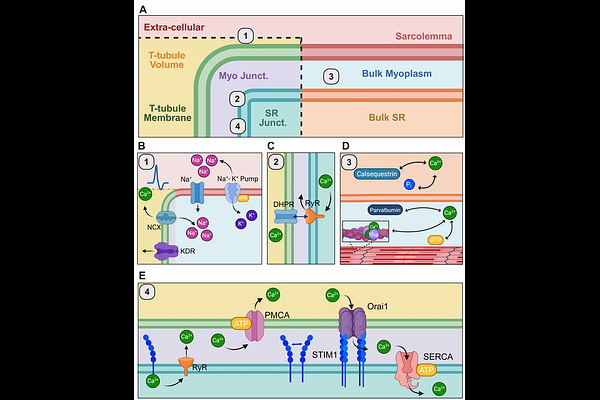Systems modeling reveals that store-operated calcium entry modulates force and fatigue during exercise

Systems modeling reveals that store-operated calcium entry modulates force and fatigue during exercise
Francis, E. A.; Hamid, J.; Kumar, A.; Rangamani, P.
AbstractThe dynamics of calcium ions in skeletal muscles link electrochemical activation and contractile force generation. An improved quantitative understanding of the mechanisms by which calcium dynamics modulate force production is crucial for optimizing muscle performance. Recent experimental data suggest that store-operated calcium entry (SOCE), the process of extracellular calcium influx upon depletion of calcium from the sarcoplasmic reticulum (SR), helps delay the onset of muscle fatigue. However, the mechanistic links between SOCE and sustained force generation in muscle remain unclear. We hypothesize that SOCE regulates force generation during sustained muscle activity by facilitating SR calcium store refilling. We test this hypothesis with a quantitative biophysical model that simulates the biochemical events of muscle contraction, from initial depolarization at the sarcolemma and T-tubules to calcium release from the SR to calcium binding and force generation throughout the myoplasm. We also consider the balance between calcium removal from the myoplasm and SOCE through the T-tubule membrane. We estimate free parameters in the model by fitting them to experiments that measured sarcolemma membrane voltage and myoplasmic calcium transients in single muscle fibers in vitro. We then test the effects of SOCE inhibition on calcium dynamics and force production and find that the magnitude of myoplasmic calcium and force are significantly lower than in wild-type cells over repetitive stimuli. Finally, we predict the effects of varying the degree of SOCE inhibition during patterns of stimulus chosen to mimic those observed during resistance exercise or high-intensity interval training. These simulations predict a context-dependent relationship between force generation and SOCE, wherein increased SOCE is associated with greater force production during resistance exercise, but worsens the effects of fatigue in certain cases of high-intensity training.